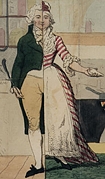 |
|
|
Is one path more fruitful than another? Or is it best to move back and forth between the specific events and the observation of general patterns in the past? It is worth pausing here to reflect a bit on what you have done and the most effective strategies for doing history... Good historians work back and forth between the specific and the general. To understand a specific event in the past, we must attune to the larger context: the economy, the politics, the social and technological changes of the period, perhaps the personal and family histories of the people involved, and such. Likewise, to make valid comments about the big picture, we must work from the specifics. We sort through the masses of particulars to uncover patterns and trends. So the story is in the details, but we must tease the story from the details. Working from the details, we make educated guesses about what might have happened and why. We start trying to frame a bigger picture. Going back to the details, we see if the pieces all fit together. We usually discover more evidence that compels us to change the picture. Now do all the pieces fit?, we ask. On we go, working back and forth between the specific and the general. You have seen many of the particulars about the Martha Ballard story. Now would you like to see and read what other people have concluded about Martha Ballard, Ben Page, and man-midwifery from the same documents you have just explored? How does the medium -- book, film, website -- affect the story that is told?
Would you like to investigate this subject further? What happened to midwives and man-midwives? The trend in medicine from female midwives to professional male doctors continued after Martha's lifetime. In studying the forms in which the division of labor between men and women has appeared in history, we can use many different kinds of documents. This 1930 occupational census summary is a good example of documentation from another era. It shows us that the medical division of labor continued. Ask yourself these questions: How many females were doctors in 1930? Males? How many females were nurses in 1930? Males? How many females were midwives in 1930? Males? What other documents might help explain why there was such a gender difference in health care jobs? There are many books about the history of midwifery and medicine that can help you explore these questions.
What would Martha Ballard confront in our world today? Has the controversy ended? You could find recent chapters of this story by researching who attends to the births of babies now where you live. Perhaps you could spot change by researching birth a generation or two ago. How about your own birth? Find medical records. Interview people about their own birth experiences. Talk to doctors and midwives. explore hospital and birth center policies. Look at laws regulating midwives. Check on statistics like those in the U.S. Census. What stories do the pieces of evidence tell?
|
|
||||||||||||||||||